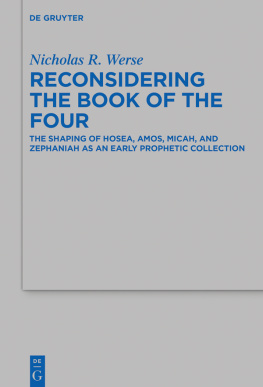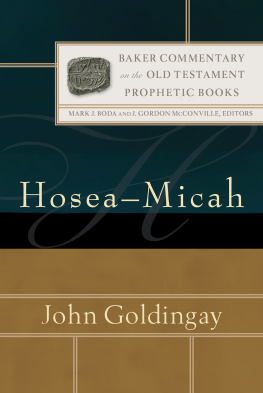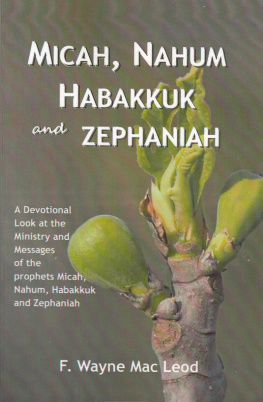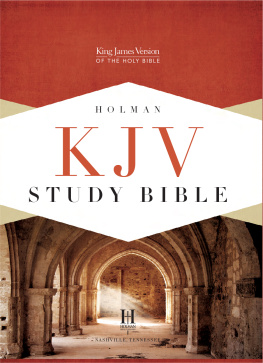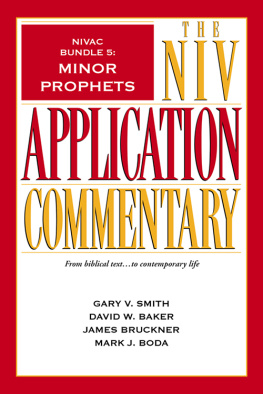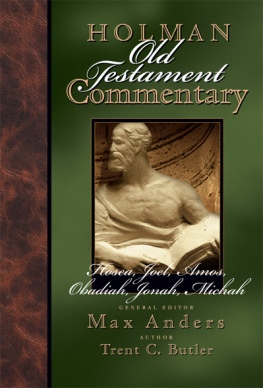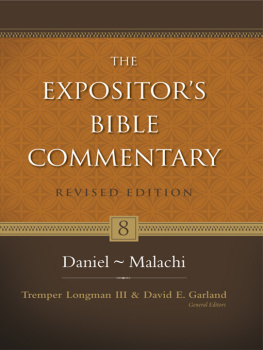Contents
Guide

Nicholas R. Werse
Reconsidering the Book of the Four
Beihefte zur Zeitschrift fr die alttestamentliche Wissenschaft

Edited by
John Barton, Reinhard G. Kratz, Nathan MacDonald, Carol A. Newsom, and Markus Witte
Volume 517
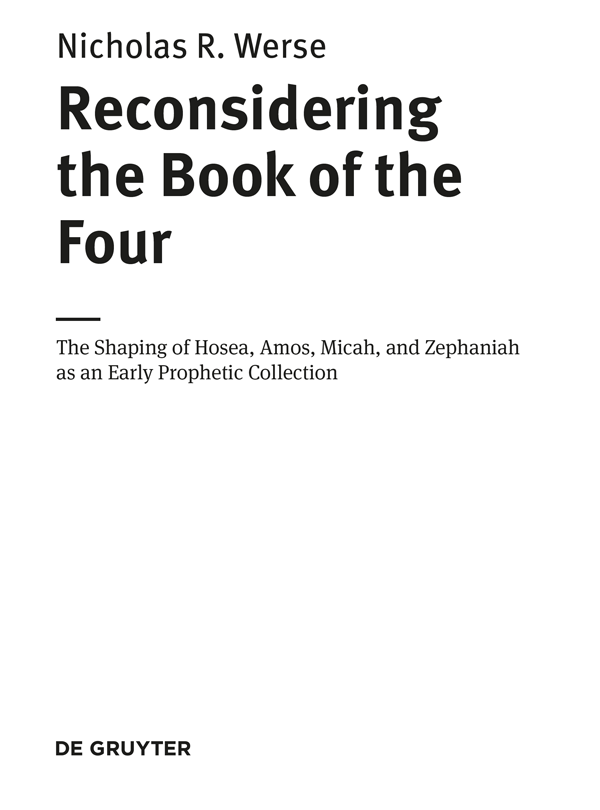
ISBN 978-3-11-064621-4
e-ISBN (PDF) 978-3-11-065026-6
e-ISBN (EPUB) 978-3-11-064994-9
ISSN 0934-2575
Library of Congress Control Number: 2019933418
Bibliografische Information der Deutschen Nationalbibliothek
The Deutsche Nationalbibliothek lists this publication in the Deutsche Nationalbibliografie; detailed bibliografic data are available on the Internet at http://dnb.dnb.de.
2019 Walter de Gruyter GmbH, Berlin/Boston
www.degruyter.com

To my wife Jennifer,
for walking with me every step of the way
Acknowledgements
Words cannot express how grateful I am for the opportunity to have studied at Baylor University. The friends, colleagues, and mentors that form this academic community made the last several years a remarkable experience in my academic pilgrimage. This volume never would have been a reality if it hadnt been for the encouragement and support of so many educators. I am forever thankful for my first Hebrew professors, Dr. Frank Patrick and Dr. Nathan Lane, for instilling within me a love for the Hebrew language. I am thankful for my seminary professors, Dr. Stephen B. Reid and Dr. W. Dennis Tucker, Jr., for cultivating my love for the Hebrew text and inspiring me to pursue doctoral work. I am thankful to Dr. James Kennedy for mentoring me as both a graduate student and as an educator committed to the craft of teaching. I would also like to express my gratitude to Dr. Sophie Wagenhofer, Alice Meroz, and the BZAW editorial board at de Gruyter for their assistance throughout this process.
My time at Baylor would not have been nearly as enjoyable without the friendship and support of my colleagues. I am especially thankful for B. J. Parker, whose charitable responses deeply shaped the way I engage in scholarly dialogue today. I feel forever indebted to Libby Ballard and Anna Sieges Beal for recruiting me into Book of the Twelve scholarship. I am thankful for Rebecca Poe Hays and Lacy Crocker Papadakis, who contributed more to my growth as a writer than they will ever know. I have Jeremy Larson to thank for devoting so much time to carefully reading parts of this dissertation and commenting on places where the argument needed clarification. My experience at Baylor instilled within me the conviction that all learning is communal. When I think about the community of students currently studying the Hebrew Bible at Baylor University, I feel immensely honored to have had the opportunity to travel this journey along with them.
This dissertation has most been shaped by the tireless work of my dissertation committee, who have devoted years to prepare me for this project, in addition to the many hours they spent reading it. I am grateful for Dr. W. H. Bellinger, Jr. and Dr. Deirdre Fulton for always being available to answer questions, and encourage me to consider scholarly conventions and trajectories outside of my academic silo in the Book of the Twelve. I am thankful for Dr. Joel Burnett and Dr. W. Dennis Tucker, Jr., for devoting countless hours to reading this project at its many stages over the last two years. This project has benefited immensely from their comments, questions, and careful attention to detail. Last but not least, this project bears the unmistakable imprint of my dissertation adviser, Dr. James D. Nogalski. Dr. Nogalski first introduced the Book of the Four hypothesis to Book of the Twelve scholarship in his published doctoral dissertation. Many of the questions that I ask of the text have been shaped by countless conversations with Dr. Nogalski in seminars, his office, and the hallways of the Religion Department. As my dissertation advisor, he read and reread countless drafts of these chapters each time writing many pages of valuable feedback, questions, and encouragements. I could not have asked for a better teacher, advisor, and mentor.
As many doctoral students will testify, the decision to pursue graduate studies is often a family affair. I feel immensely thankful to have taken this journey with my wife Jennifer. Ever since we first decided that I should apply to Baylor University, we have traveled this academic journey together. The most enjoyable part of my education consisted of the long nights that we sat up talking about any number of interconnected religious themes. Her steady insights and thought-provoking questions never ceased challenging me to apply what I was learning to questions outside of my academic focus. I am overjoyed that we get to celebrate the publication of this volume with our children Aiden and Alivia. Aiden joined us as work on this volume began and Alivia entered our lives at the conclusion of this project. Words cannot express how much joy you both have brought into our lives.
List of Tables
| Complete Book of the Four Proposed Editorial Additions |
| Hosea Similarities with Deuteronomistic Thought |
| Five Part Formulas |
| Hos 12:1[11:12]13:9 Literary Patterning |
| The Refusal to Turn in the Prophets |
| The Violence of Samaria |
| Superscriptional Regnal Dating Schemas |
| Hos 4:15ab and Amos 4:4a; 5:5; 8:14 |
| The Scribal Program of Literary Integration in Hos 4:15ab |
| Consuming Fire in the Book of the Twelve |
| Hosea 4:3 and Zephaniah 1:23 |
| Formulaic Creation Categories |
| Proposed Book of the Four Additions in Amos |
| The Exodus Formula in Amos |
| Regnal Dating in Hosea and Amos |
| Hosea language in Amos 2:4b |
| The Literary Horizon of Micah 2:3 |
| Proposed Book of the Four Supplements in Micah |
| Comparison of Micah 1:6 and 3:12 |
| Formulaic introductions of Micah 5:9[10] and Zechariah 13:2 |
| Common Exodus Language In Mic 6:4a |
| Superscriptional formula |
| Regnal Dating Comparisons |
| Superscriptional Formulas |
| Superscriptional Regnal dating |
| Comparison of Micah 1:6 and 3:12 |
| The Literary Horizon of Micah 2:3 |
| Structure of Micah 2:1 and 2:3 |
| Comparison of Mic 2:12 and Zeph 2:7, 9b; 3:13 |
| Hosea 4:10a and Micah 6:14 |
| Structural Comparison of Mic 3:812 and 6:9ab, 1016 |
| Aaron Scharts Hraufrufe structure |
| Micah 3:1, 9 Refrain |
| Nogalskis Links between Mic 6 and Zeph 1:12:3 |
| Proposed Book of the Four Additions in Zephaniah |
| Zephaniah and Deuteronomy Similarities |
| Formulaic Uses |
| 5.4 | Redactional Development of Zeph 1:24 |
| Seeking YHWH in Zephaniah |
| Zephaniah 2:56 structure |
| Zephaniah 3:2 and Jeremiah 7:28 Parallel |

